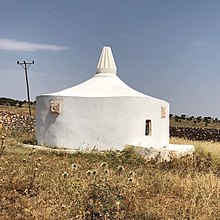Yazidism in Turkey
Yazidism in Turkey refers to adherents of Yazidism from Turkey, who remained in Turkey after the dissolution of the Ottoman Empire. The Yazidis living in Turkey during and after the second half of the 20th century gradually left for European countries. In the 1980s, there were 60,000 Yazidis situated in Beşiri, Kurtalan, Bismil, Midyat, Idil, Cizre, Nusaybin, Viranşehir, Suruç and Bozova. Today, these places are almost empty due to exodus to Europe which was provoked by political, religious and economic difficulties. Today only small number remain in villages around Midyat, Viranşehir, Çınar and Beşiri. According to the census of 2000, only 423 individuals adhering to Yazidism remained in the country.[1]

Demography
According to the Society for Threatened Peoples, 300,000 Yazidis originally lived in Turkey.[2][when?]
In the 1980s, the number of Yazidis in Turkey was around 60,000.[3][4] In 1993, the number was estimated to be 24,309.[5]
In 2003, the United States Department of State's Bureau for Democracy, Human Rights, and Labor stated that 5,000 Yazidis live in Turkey.[6]
In 2004, the Federal Office for Migration and Refugees reported that more than 2,000 Yazidis (mainly in south-eastern Anatolia) live in Turkey.[7]
In 2019, the number of Yazidis in Turkey was less than 1,000 according to the United States federal government estimate.[8]

Settlement areas
Historically, the Yazidis lived in Turkey in the east, south, and south-east of Turkey.[4] The current settlement area of Yazidis in Turkey includes Midyat and Nusaybin counties in Mardin province, Batman and Beşiri counties in Batman province and parts of İdil counties in Şırnak province. Other Yazidi settlement areas are in Sur, Bismil and Çınar counties in Diyarbakır province and in Viranşehir district in Şanlıurfa province.

History

Yazidis are native to an area of the Middle East historically known as Mesopotamia (more specifically, they are indigenous to the northern part of Mesopotamia) which also includes southeastern Turkey.[9]
The modern state of Turkey was founded in 1923. Yazidis lived on the territory of present-day Turkey before the establishment of the modern state of Turkey. Yazidi tribes lived in the Ottoman provinces of Mosul, Diyarbekir, Van, Bitlis and Aleppo after Sultan Selim conquered eastern Anatolia, Mosul and Syria between 1514 and 1516.[10]
In 1844, the Yazidis in Turkey, who were in the Tur Abdin region, were massacred by the Kurdish prince Bedirkhan Beg and his troops.[11]
Recently, some Yazidis who are from Turkey and have lived in Germany have returned to their villages in Turkey.[12]

Exodus to the Caucasus
In the 19th century and in the early 20th century, the Yazidis in began to flee the
Armenian Genocide
Yazidis were massacred alongside
Escape to Germany
Due to persecution, oppression and discrimination, Yazidis fled Turkey in two major immigration waves, the first wave began in the 1960s; many Yazidis were among the guest workers from Turkey. Some settled in Celle, where the Telefunken company started producing color televisions in a new factory here in 1966. The second wave took place after the 1980 Turkish military coup. When Yazidis, like many of their fellow Kurds, suffered under the dictatorship of General Kenan Evren. Yazidis were recognized as a persecuted group for the first time by the administrative court of Stade and after the next few years, North-Rhine Westphalia followed suit as a federal state.[22] After fleeing, the Federal Constitutional Court also declared the Yazidis to be a persecuted group.[23]
According to the German Bundestag, the majority of Yazidis have left Turkey in the last 30 years.[24]
In 1989, Gernot Wießner and Herbert Schnoor traveled to Turkey with a delegation to see for themselves the persecution of the Yazidis. They campaigned in North Rhine-Westphalia for the right to stay for the Yazidis, whereupon the Yazidis were recognized as a persecuted group in Germany.[25]
See also
- Yazidis in Iraq
- Yazidis in Syria
Literature
- Çakır Ceyhan Suvari: Yezidis: An Ethno-Religious Group in Turkey (2016)
- Rohat Cebe, Ersoy Soydan: Batman Yezidis and Yezidis Oral Tradition (2012)
References
- )
- ^ "Yeziden". Gesellschaft für bedrohte Völker e.V. (GfbV). Retrieved 2022-02-04.
- ISBN 978-0-85772-061-0.
- ^ a b "Yezidis (Ezidis)". Minority Rights Group. 2015-06-19. Retrieved 2022-02-04.
- ^ Turan, Ahmet (1993). Yezidiler Tarihçeleri Coğrafi Dağılımları İnançları Örf ve Adetleri (in Turkish). p. 54.
- ISBN 978-1-351-79789-4.
- ^ "Rückkehr von Yeziden in die Türkei" (PDF). Bundesamt für Anerkennung ausländischer Flüchtlinge. 2004. Archived from the original (PDF) on 2019-01-03. Retrieved 2022-02-04.
- ^ "DFAT Country Information Report Turkey" (PDF). Australian Government - Department of Foreign Affairs and Trade. 2020. p. 22. Retrieved 2022-02-04.
- ISBN 978-1-4408-6118-5.
- ^ Gölbaşı, Edip (2008). "The Yezidis and the Ottoman State: Modern Power, Military Conscription, and Conversion Policies, 1830-1909" (PDF). p. 5. Retrieved 2022-02-04.
- ^ Tagay, Sefik; Ortac, Serhat (2016). "Die Eziden und das Ezidentum – Geschichte und Gegenwart einer vom Untergang bedrohten Religion" (PDF) (in German). Landeszentrale für politische Bildung, Hamburg. p. 50. Retrieved 2022-02-04.
- ^ "Jesiden in der Türkei: Alte Heimat, neue Heimat - Qantara.de". Qantara.de - Dialog mit der islamischen Welt (in German). 7 May 2015. Retrieved 2022-02-04.
- S2CID 235524798, retrieved 2022-06-22
- ^ a b "A Conditional Coexistence:Yezidi in Armenia". www.culturalsurvival.org. 26 March 2010. Retrieved 2022-02-04.
- ISBN 978-0-19-086972-4.
- ISBN 978-3-8288-6546-4.
- ^ a b "How did Yezidis become Muslim?". www.rudaw.net. Retrieved 2022-02-04.
- ^ "Armenia is the only country in the world where Yazidis are taught at school in their own language: The National News". www.1lurer.am. 15 April 2021. Retrieved 2022-02-04.
- ISBN 978-1-108-58301-5.
- ISBN 978-3-95971-947-6.
- ISBN 978-90-485-1928-6.
- ISSN 0931-9085. Retrieved 2022-02-04.
- ISBN 978-3-11-044656-2.
- ^ "Antwort der Bundesregierung" (PDF). German Bundestag. 2014. p. 1. Retrieved 2022-02-04.
- ^ Schnoor, Herbert (2001). Unvergessen in: Der Herr schafft Gerechtigkeit und Recht (in German). Wuppertal. pp. 59–67.
{{cite book}}: CS1 maint: location missing publisher (link)
